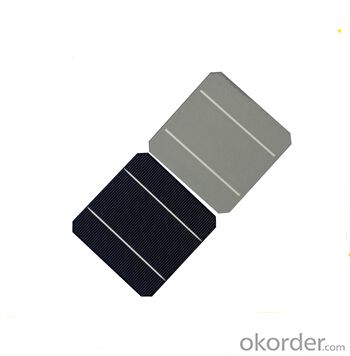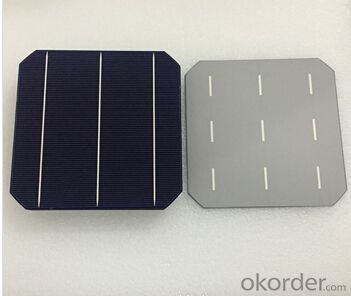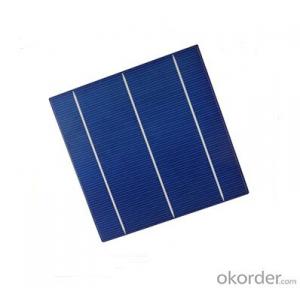UV Monocrystalline Solar Cells Format:156 mm x 156 mm
- Loading Port:
- Shanghai
- Payment Terms:
- TT or LC
- Min Order Qty:
- 5000 pc
- Supply Capability:
- 8000000 pc/month
OKorder Service Pledge
OKorder Financial Service
You Might Also Like
Monocrystalline Solar Cells A GRADE
A solar cell, is an electrical device that converts the energy of light directly into electricity by the photovoltaic effect, which is a physical and chemical phenomenon. It is a form of photoelectric cell, defined as a device whose electrical characteristics, such as current, voltage, or resistance, vary when exposed to light. Solar cells are the building blocks of photovoltaic modules, otherwise known as solar panels.
Advantage of Monocrystalline Solar Cells
1.Tire-1 Solar Cells’ Manufacturer Quality Guarantee. With a complete and sophisticated quality government system, our Quality Management have arrived world’s leading place. Customer can receive Tire-1 Cells Maker’s Quality Standard Products.
2.Trusted Warranty. We can supply trusted after-sales service to our customer. If our cells are found not in conformity to the specification of manufacturer, or should the inspected quantity found in shortage, or should the packing found damaged, the buyer has the right to claim to the seller. The claim, if any, should be presented to seller within 30 days after cargo's arrival date to the port, together with related inspection report and photos issued and provided by a reputable independent surveyor such as SGS.
3.World’s Leading Manufacturer Equipment. We imported the newest and leading production equipment from abroad. Advanced equipment can guarantee the stable quality of cells. Auto production line can also save labor cost which will further cut our production cost.
Specifications of Monocrystalline Solar Cells
Format : 156 mm × 156 mm ± 0.5 mm
Thickness: 210 μm ±40 μm
Front (-) : 1.5mm bus bars (silver),blue anti-reflection coating (silicon nitride)
Back (+) : 2.5mm wide soldering pads (silver) back surface field (aluminium)
Efficiency (%) Pmpp (W) Umpp (V) Impp (A) Uoc (V) Isc (A) |
18.20% 4.43 0.536 8.263 0.634 8.712 |
18.00% 4.38 0.535 - 8.188 0.633 8.701 |
Usage of Polycrystalline Solar Cells
Solar cells are often electrically connected and encapsulated as a module. Photovoltaic modules often have a sheet of glass on the front (sun up) side, allowing light to pass while protecting the semiconductor wafers from abrasion and impact due to wind-driven debris, rain, hail, etc. Solar cells are also usually connected in series in modules, creating an additive voltage. Connecting cells in parallel will yield a higher current; our solar cells have passed IEC Certification. With high and stable quality, our cells can greatly improve the performance of Solar Modules.
FAQ
We have organized several common questions for our clients,may help you sincerely:
1.What’s price per watt?
A: It’s depends on the quantity, delivery date and payment terms of the order. We can talk further about the detail price issue. Our products is high quality with lower price level.
2.Can you tell me the parameter of your solar cells?
We have different series of cells with different power output, both from c-si to a-si. Please take our specification sheet for your reference.
3.How do you pack your products?
We have rich experience on how to pack the panels to make sure the safety on shipment when it arrives at the destination.
4.Can you do OEM for us?
Yes, we can.
5.How long can we receive the product after purchase?
In the purchase of product within three working days, We will arrange the factory delivery as soon as possible. The perfect time of receiving is related to the state and position of customers. Commonly 7 to 10 working days can be served.
How solar cells are made
How the new materials change the made processes of solar cells.
At present, most of the solar battery board's advocated material is crystalline silicon. Crystal itself or crystal sediments above can be mixed with some other metal atoms, the atoms can combine with the silicon atoms and appear electrons, electrons can selectively generates hole, both of them can enhance the conductivity of crystal. After doping process of crystalline silicon solar cell conversion efficiency can be more than 20%, and without doping battery's efficiency never exceeded 14%.
Doping process can improve the conversion efficiency of solar energy, but it will increase the complexity of the semiconductor devices and lower its performance, exam the following manufacturing processes. Special hybrid materials in the new study can omit doping process, only need seven simple steps, it can combine new materials and simple coating process to improve efficiency. As the department of energy's Lawrence Berkeley national laboratory and the university of California, Berkeley, visiting scholar, James & dot; Block the related achievements as the first author published in the journal nature & dot; energy, he said: "we're making solar cells structure is simple, can effectively reduce the cost."
In this study, the research team at the side of the solar battery for solar silicon wafer, coated with a thin layer of molybdenum oxide, lithium fluoride is used on the back of the material. Both of the coatings only have dozens of nanometers thick and they are transparent. Because of the complementary electronic structure, it becomes very suitable for use in a solar cell.
Made your own simplest Solar Cell
Use the metal sheers to cut two pieces of copper approximately 3” x 4”. Place one piece of copper directly on the electric burner at high heat. As the copper starts to heat up, you will see an oxidation pattern start to form. After a few minutes, the colors from the oxidation pattern will be replaced by a thick black cupric oxide (CuO) coating. Leave the copper plate on high heat for one half hour to develop a thick black oxide layer. After one half hour turn off the burner and let the copper sheet slowly cool on the burner allowing the cupric oxide layer to flake off exposing a reddish-orange cuprous oxide (Cu2O) layer underneath. Once cooled, remove the copper plate from the burner and gently flake off the remaining black cupric oxide using a paper towell or by running water over it.
Cut the top off of the plastic water bottle. Bend both the heat-treated copper plate and the clean copper plate to fit on the inside of the plastic water bottle. The two sheets should not touch. Next attach an alligator clip to each sheet and attach the positive terminal of the meter to the clean copper plate and the negative terminal to the cuprous oxide coated plate.
Dissolve two tablespoons of salt in about two cups tap water, and fill the water bottle with salt water leaving about an inch at the top to avoid getting the alligator clips wet.
Once the cell is complete take a meter reading both indoors and outside. In direct sunlight, the multimeter should read a current of up to 50 microamps and a voltage of approximately 0.25 volts.
- Q: How do solar cells perform in regions with high levels of air pollution?
- Solar cells generally perform less efficiently in regions with high levels of air pollution. Air pollution can block sunlight and reduce the amount of light reaching the solar cells, thereby reducing their performance. Additionally, pollutants in the air can settle on the surface of the solar cells, forming a layer of dust or dirt, which further reduces their efficiency. Regular cleaning and maintenance of solar panels are necessary in polluted regions to ensure optimal performance.
- Q: How do solar cells handle bird droppings or other debris?
- Solar cells are generally designed to be self-cleaning or have a protective coating that prevents bird droppings or debris from significantly impacting their performance. Rainwater or regular cleaning can often wash away most of the dirt or droppings, ensuring optimal solar energy generation.
- Q: Can solar cells be used to power surveillance cameras?
- Yes, solar cells can be used to power surveillance cameras. Solar power can provide a reliable and sustainable source of energy for surveillance cameras, eliminating the need for traditional electrical wiring or frequent battery changes. Solar panels can capture sunlight and convert it into electricity, which can then be stored in batteries to power the cameras day and night. This makes solar-powered surveillance cameras an eco-friendly and cost-effective solution, particularly in remote or off-grid locations.
- Q: Which one is better on the solar cells panel? The Monocrystal Solar Energy Cell or photovoltaic cell?
- Since most of people I know, the function of the solar cell is for some home-based lighting and watching TV, it doesn't really matters if it is Single crystal silicon or polycrystalline silicon solar energy cell.
- Q: How do solar cells affect the electric grid?
- Solar cells can have a positive impact on the electric grid by generating clean and renewable energy. When connected to the grid, they can feed excess electricity back into the system, reducing the demand for power from traditional sources. This helps to decrease reliance on fossil fuels and lowers greenhouse gas emissions. However, the intermittency of solar power can pose challenges for grid operators in managing fluctuations in supply and demand.
- Q: Which Solar Panel Type is best? Polycrystalline panel or PV Module Monocrystalline Solar cell panel, or thin film?
- PV Module Monocrystalline Solar cell panels is most efficient since they are made from the highest-grade silicon.
- Q: How do solar cells perform in areas with high levels of snowfall?
- Solar cells generally do not perform optimally in areas with high levels of snowfall. The accumulation of snow on the surface of solar panels can significantly reduce their efficiency by blocking sunlight and preventing the cells from generating electricity. Regular snow removal or tilting the panels at an angle can help mitigate this issue, but it may still impact their overall performance in such regions.
- Q: I am a purchasing manager for a EPC engineering company, and we are planning to purchasing some 4bb solar cells for one of our project in Taiwan, can I get a quotation online?
- You can check our product, here are the product details for your information: Mono Solar Cell, 4BB:6x6 inch (156mm*156mm)
- Q: Can solar cells be used in public transportation?
- Yes, solar cells can be used in public transportation. Solar panels can be installed on the roofs of buses, trains, and trams to generate electricity from sunlight. This renewable energy can be used to power various systems in public transportation, such as lighting, air conditioning, and even charging onboard devices. Additionally, solar cells can also be used to charge electric vehicles used in public transportation, reducing reliance on fossil fuels and contributing to a more sustainable transportation system.
- Q: Which brand of the solar cells is sold with the lower price on the market? Which brand is more practical for the countryside?
- Sometimes the lower price solar cells mean you might have to take the risk of low quality solar cell.
Send your message to us
UV Monocrystalline Solar Cells Format:156 mm x 156 mm
- Loading Port:
- Shanghai
- Payment Terms:
- TT or LC
- Min Order Qty:
- 5000 pc
- Supply Capability:
- 8000000 pc/month
OKorder Service Pledge
OKorder Financial Service
Similar products
Hot products
Hot Searches
Related keywords


























